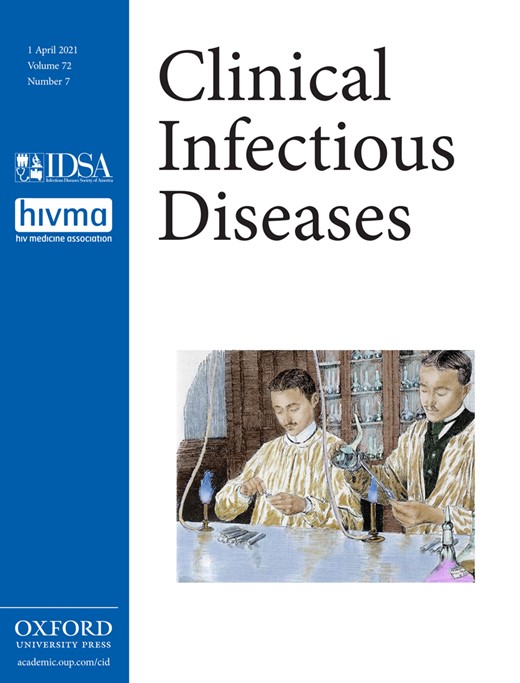
Cover image

Volume 72, Issue 7, 1 April 2021
IN THE LITERATURE
In the Literature
IDSA FEATURES
Infectious Diseases Society of America Guidance on the Treatment of Extended-Spectrum β-lactamase Producing Enterobacterales (ESBL-E), Carbapenem-Resistant Enterobacterales (CRE), and Pseudomonas aeruginosa with Difficult-to-Treat Resistance (DTR-P. aeruginosa)
MAJOR ARTICLES AND COMMENTARIES
First European Haplotype of Echinococcus multilocularis Identified in the United States: An Emerging Disease?
We have identified the first case of a European haplotype Echinococcus multilocularis in the United States. Given the recent identification of this haplotype in Canada, this may be an emerging infectious disease in North America.
Advanced Alveolar Echinococcosis in a New Geographic Area
Variability in the Management of Adults With Pulmonary Nontuberculous Mycobacterial Disease
Mycobacterium avium-intracellulare complex, M. kansasii, and M. abscessus were the most common cause of pulmonary Nontuberculous Mycobacterial Disease (NTM). Mangement of pulmonary NTM was heterogenous and cure rate was low. Adherence to ATS/IDSA guidelines and follow-up of selected patients without treatment are important.
Is It Time to Move the Goalposts?
Altered Immune Reconstitution in Allogeneic Stem Cell Transplant Recipients With Human Immunodeficiency Virus (HIV)
We describe T-cell reconstitution postallogeneic stem cell transplantation in 6 people with human immunodeficiency virus (HIV) compared to 21 controls without HIV. We observed a significantly elevated CD8+ T-cell expansion post-Allogeneic Stem Cell Transplant in recipients with HIV. The nature and specificity of the CD8+ T-cell population differed among individuals.
Effectiveness of Trivalent and Quadrivalent Inactivated Vaccines Against Influenza B in the United States, 2011–2012 to 2016–2017
During the 4 influenza seasons beginning in 2013–2014, trivalent and quadrivalent inactivated influenza vaccines provided equivalent protection against any influenza B illness in the United States, while quadrivalent vaccines provided better protection against the added B virus lineage.
Maternal and Infant Outcomes Among Pregnant Women Treated for Multidrug/Rifampicin-Resistant Tuberculosis in South Africa
Pregnant women with Multidrug/Rifampicin-resistant-tuberculosis can be effectively and safely treated. We observed a relationship between the use of bedaquiline and low birth weight, but the clinical importance of this finding is unclear.
Good Outcomes in Babies With In Utero Bedaquiline Exposure
Searching and Finding the Hidden Treasure: A Retrospective Analysis of Rickettsial Disease Among Dutch International Travelers
Rickettsial disease is an important and poorly recognized cause of illness in travelers, specifically when an inoculation eschar is absent. A lower threshold to test and treat is warranted in returning travelers with febrile illness, regardless of eschar presence.
Rickettsioses: “A Treasure Is Hidden in This Garden”
A Randomized Controlled Trial of Ceftriaxone and Doxycycline, With or Without Metronidazole, for the Treatment of Acute Pelvic Inflammatory Disease
Treatment of acute pelvic inflammatory disease with ceftriaxone, doxycycline, and metronidazole is associated with significantly less frequent recovery of anaerobic organisms from the upper genital tract, decreased Mycoplasma genitalium, and improved clinical response compared to ceftriaxone and doxycycline.
To Effectively Treat Pelvic Inflammatory Disease, Look Beyond Coverage for Gonorrhea and Chlamydia
Varicella Zoster Virus Encephalitis in Denmark From 2015 to 2019—A Nationwide Prospective Cohort Study
We identified 92 adults with Varicella Zoster Virus encephalitis primarily affecting elderly or immunocompromised patients. Diagnosis and treatment are often delayed; cerebral vasculitis is not uncommon (16%). Risk factors for unfavorable outcome are age, cerebral vasculitis, and Glasgow Coma Scale score <15.
A Prospective, Population-based Study to Determine the Incidence and Bacteriology of Bacterial Conjunctivitis in Children <2 Years of Age Following 7-Valent and 13-Valent Pneumococcal Conjugate Vaccine Sequential Implementation
Thirteen-valent pneumococcal conjugate vaccine led to a decline in pneumococcal and all-cause bacterial conjunctivitis. As with observations in otitis media, reduction occurred also in diseases caused by nontypeable Haemophilus influenzae, suggesting its interaction with pneumococcus in conjunctivitis pathogenesis.
Unraveling the Impact of Pneumococcal Conjugate Vaccines on Bacterial Conjunctivitis in Children
Epidemiology of Escherichia coli Bacteremia: A Systematic Literature Review
This systematic review regarding the epidemiology of Escherichia coli bacteremia in high-income countries shows that the disease burden is greatest in the elderly, and that most episodes have a community onset and result from urinary tract infection.
Predictive Value of 3 Clinical Criteria for Sepsis (Quick Sequential Organ Failure Assessment, Systemic Inflammatory Response Syndrome, and National Early Warning Score) With Respect to Short-term Mortality in Allogeneic Hematopoietic Cell Transplant Recipients With Suspected Infections
Sepsis disproportionately affects hematopoietic cell transplant (HCT) recipients, but clinical criteria currently recommended in sepsis detection have not been validated in these patients. We demonstrate the limited predictive value of commonly used clinical criteria among HCT recipients with suspected infections.
A Sepsis Screening Tool for Hematopoietic Cell Transplant Recipients Remains Elusive
Invasive Mycobacterium abscessus Complex Infection After Cardiac Surgery: Epidemiology, Management, and Clinical Outcomes
Cardiac surgery patients with invasive Mycobacterium abscessus complex infection received aggressive and prolonged medical and surgical therapy. However, patients with these infections experienced substantial morbidity and mortality. Novel treatment strategies are needed, and close attention to infection prevention remains paramount.
BRIEF REPORTS
Early Results from Severe Acute Respiratory Syndrome Coronavirus 2 Polymerase Chain Reaction Testing of Healthcare Workers at an Academic Medical Center in New York City
Loss of Smell and Taste Among Healthcare Personnel Screened for Coronavirus 2019
Use of Baricitinib in Patients With Moderate to Severe Coronavirus Disease 2019
The Emergence of Baricitinib: A Story of Tortoises Versus Hares
Comparing Nasopharyngeal and Midturbinate Nasal Swab Testing for the Identification of Severe Acute Respiratory Syndrome Coronavirus 2
Drug-induced Liver Injury in a Patient With Coronavirus Disease 2019: Potential Interaction of Remdesivir With P-Glycoprotein Inhibitors
VIEWPOINTS
Investigator-initiated Randomized Controlled Trials in Infectious Diseases: Better Value for Money for Registration Trials of New Antimicrobials
Costs of investigator-initiated trials are lower than those of industry-sponsored trials. We present our viewpoint on the sources of these costs and compare trials’ aims and methods. We propose a greater role for academic clinical trials networks, especially for antibiotic development.
Proposing Minimum Requirements for Announcing Clinical Trial Results During the COVID-19 Pandemic
We propose a minimum set of trial characteristics and results to be released simultaneously with clinical trial announcements.
REVIEW ARTICLE
Cryptococcal Antigen in Serum and Cerebrospinal Fluid for Detecting Cryptococcal Meningitis in Adults Living With Human Immunodeficiency Virus: Systematic Review and Meta-Analysis of Diagnostic Test Accuracy Studies
In patients with symptoms suspicious of cryptococcal meningitis (CM) associated with human immunodeficiency virus, a positive serum cryptococcal antigen (CrAg) is highly presumptive of culture-confirmed CM and a positive cerebrospinal fluid CrAg is diagnostic of a first episode of CM.
INVITED ARTICLE
CLINICAL PRACTICE
Imaging a Fever—Redefining the Role of 2-deoxy-2-[18F]Fluoro-D-Glucose–Positron Emission Tomography/Computed Tomography in Fever of Unknown Origin Investigations
Data suggests 2-deoxy-2-[18F]fluoro-D-glucose–positron emission tomography/computed tomography is a useful imaging technique for the evaluation of fever of unknown origin as it improves diagnostic efficiency and reduces costs. Clinicians should consider this useful tool when preliminary studies are unrevealing.
PHOTO QUIZ
An Uncommon Cause of Chronic Cough
CORRESPONDENCE
Perspective of a Physician Who Tested Persistently Positive for Coronavirus Disease 2019
Whole Nucleocapsid Protein of Severe Acute Respiratory Syndrome Coronavirus 2 May Cause False-Positive Results in Serological Assays
Reply to Yamaoka, et al
Cefazolin Shortages in the Developing World: The Same, But Different Too
Reply to Kakkar et al
Fecal Microbiota Transplant: Keep Calm and Carry On, Learning From Experience
High-dose but Not Low-dose Corticosteroids Potentially Delay Viral Shedding of Patients With COVID-19
Influence of Corticosteroid Dose on Viral Shedding Duration in Patients With COVID-19
ONLINE ONLY ARTICLES
Infectious Diseases Society of America Guidance on the Treatment of Extended-Spectrum β-lactamase Producing Enterobacterales (ESBL-E), Carbapenem-Resistant Enterobacterales (CRE), and Pseudomonas aeruginosa with Difficult-to-Treat Resistance (DTR-P. aeruginosa)
Impact of Nonpharmaceutical Interventions on the Incidence of Respiratory Infections During the Coronavirus Disease 2019 (COVID-19) Outbreak in Korea: A Nationwide Surveillance Study
In this ecological study using a nationwide notifiable diseases database and a sample surveillance, implementation of nonpharmaceutical interventions was associated with significantly lower incidences of chickenpox, mumps, and respiratory virus infections compared with the prediction model or the preintervention period.



